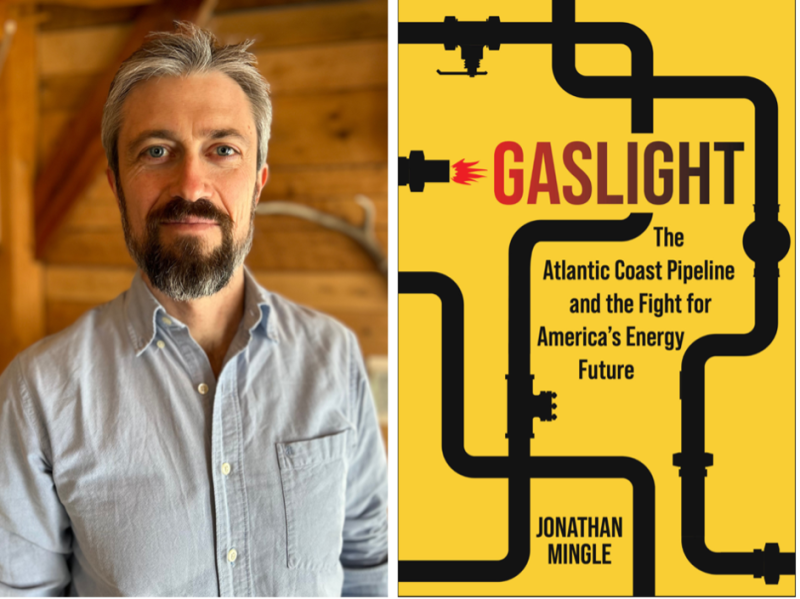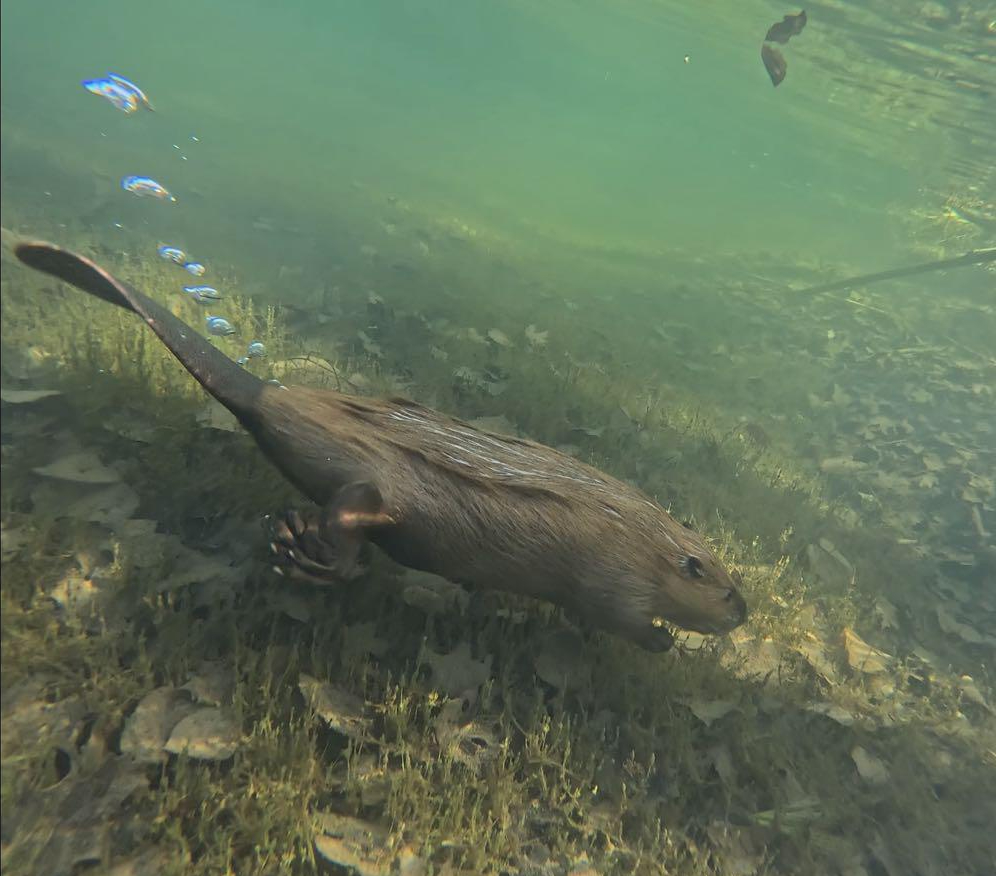
One evening, in April 2021, Rachel Siegel was sitting on her living room couch, watching TV with her husband, when she stumbled across a Facebook post about a family of beavers in her suburb of Glenview, Illinois, that was about to be trapped and killed by the local HOA. “It never occurred to me that beavers would be living in a suburb like Glenview,” Siegel says. But there the beavers were, building dens in the banks of the Chicagoland suburb’s stormwater retention ponds. There were six of them, all told—a mother and a father, a yearling, and three kits. All were about to be killed for “doing the things that their instincts tell them to do,” as Siegel puts it, “which is to build dams in our river valleys.”
Surprised to discover that a family of beavers was living in her suburb, and shocked to learn about the fate those beavers were soon to meet, Rachel knew she had to do something. “A group of us sprang into action,” she says. “We created a Facebook group. We talked to the media. We had a press release. We held a rally. We reached out to PETA. And within a couple of days, the HOA said, ‘Okay, we’re not going to trap the beavers.’”
Rachel Siegel and her grassroots group of beaver advocates urged their local government to protect the beavers. The Village of Glenview called in wildlife managers from the Illinois Department of Natural Resources, who live-trapped the beavers and moved them to another watershed in Illinois. The beavers were saved.
“I was so relieved that my beavers were safe,” Siegel says. “But then I started to think: My beavers are going to have babies this year, and they’re going to disperse. So it’s not enough that I’ve just made my little village safer for beavers. I actually need to make the whole state of Illinois safer for beavers.”
* * * *
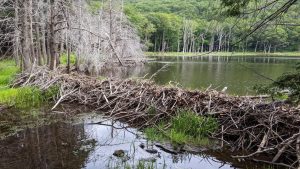
Beaver dam. Photo Credit: Ethan Ely
Beavers once thrived in the state of Illinois, as they did across so much of North America. Prior to European colonization, as many as 400 million beavers inhabited the continent, damming rivers and streams from Connecticut to California, from southern Alaska to northern Mexico. Prized for their pelts, which were used to manufacture the fashionable felt hats of the era, the North American beaver was driven to the brink of extinction by the fur trade, which made its way into the Midwest in the early 1700s. By 1900, fewer than 100,000 beavers remained in North America. The fur market collapsed around the turn of the 20th century, however, just in time to spare the beaver from extinction.
Beaver populations have been rebounding ever since. Between 10 and 15 million beavers populate North America today. Castor canadensis is slowly but surely re-expanding its range and refilling ecological niches that the species long ago occupied, in places from which the species had long been extirpated. Places like Glenview, Illinois.
“Beavers are all over [Illinois],” says Rachel Siegel. “They’re all up and down the Des Plaines and the Chicago River and the Fox River. There’s beavers in some of the harbors of Lake Michigan.” There are even beavers living in the Chicago metro area, the state’s largest and most thoroughly industrialized city. “They’re like a Darwinian success story,” Siegel continues. “They’re very adaptable. They can live in all kinds of urban settings.”
But with beavers moving into urban settings comes human-beaver conflict. The wetlands that beavers create can cause localized flooding, which can damage homes, roads, and infrastructure. For this reason, HOAs and other local entities tend to view beavers as pests. Beavers are trapped. Beavers are killed. Thousands of beavers die in human-beaver conflicts every year in Illinois alone.
“They’re not just water rats,” Rachel Siegel says. “They build habitat, which boosts biodiversity. There’s no reason why we shouldn’t be coexisting.”
How humans and beavers can coexist in Illinois in the 21st century is a cause that Rachel Siegel has dedicated herself to, ever since she helped save that family of beavers living in her village of Glenview in April 2021. She was a stay-at-home mom at the time. At 54 years old, she went back to graduate school and earned a certificate in environmental law and policy at Loyola University in Chicago. Then she founded the Illinois Beaver Alliance, a nonprofit organization working to educate the public about beavers’ ecological importance and promote modern tools for resolving human-beaver conflicts.
“I just started putting the pieces in place,” Siegel, the Illinois Beaver Alliance’s president, says. “I started reaching out to different people and through them, I met other people. And it’s gotten to the point now where we get to our 2025 summit and we’ve got 50 co hosts from around the region and another 10 sponsors.”
The 2025 Midwest Beaver Summit, which the Illinois Beaver Alliance hosted at Oakton College in Des Plaines, Illinois, on June 5 of this year, featured workshops, documentary film screenings, and talks from scientists, wildlife managers, and Indigenous knowledge keepers. Sponsors of the event included the Sierra Club, Land Trust Alliance, and Anthropocene Alliance, among other local and national conservation groups and environmental nonprofits. Made possible by a $20,000 grant from the National Fish and Wildlife Foundation’s National Coastal Resilience Fund, the summit centered on how humans and beavers can coexist in the modern world.
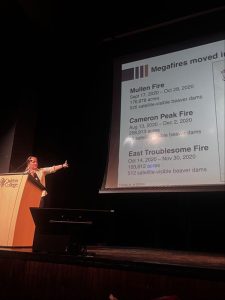
Emily Fairfax presents at the 2025 Midwest Beaver Summit. Credit: Gloria Charland
* * * *
One highlight was a presentation from Emily Fairfax, an eco-hydrologist from the University of Minnesota who studies beavers and the wetlands they engineer. When beavers build dams, they “take some of the power out” of rivers and streams, Fairfax explained. “Water is slowed, spread, and stored in the landscape,” which keeps nearby plants and soils moisturized during periods of drought. “It’s not during normal times that beavers shine,” Fairfax said, “it’s during the droughts.”
Fairfax shared data from a study that she and her team published in Ecohydrology in 2018. The researchers used remote sensing technology to study beaver ponds in northeastern Nevada during a three-year drought. Plants growing near beaver ponds were 50 to 150% wetter than those in areas without beaver ponds, the study showed. “Where we had beavers building, they kept the plants green,” Fairfax said. Where beavers weren’t building, plants became “fuel for wildfires.”
Beaver wetlands also protect against wildfires, Fairfax’s research has shown. Beaver wetlands are simply too wet to burn. “When a fire gets to the beaver wetlands,” Fairfax said, “it stops, it stalls.” Her 2020 study, published in Ecological Applications, examined wildfires across the western United States. Post-fire, “the beaver zones are the only thing that’s green,” she said. The study showed that beaver-engineered wetlands create “fire refugia,” locations on the landscape that are resistant to wildfire.
Emily Fairfax and her team conducted their studies in the American West, but Fairfax shared still more data showing that beaver wetlands provide fire-protective effects in the Midwest as well. Consider the Greenwood Fire, which sent 26,797 acres of northern Minnesota’s Arrowhead Region up in flames in 2021. Forests burned; beaver wetlands didn’t.
The ecological benefits continue: beaver dams improve water quality, recharge aquifers, and mitigate flooding. A 2020 Mammal Review study found that every square mile of beaver habitat provides $179,000 in ecosystem services each year. Other studies estimate that the planet’s beaver wetlands may store up to 470,000 tons of greenhouse gases annually.
The takeaway?
“Beavers are our partners in climate resilience,” Fairfax concluded.
* * * *
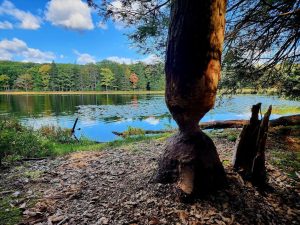
Close-up of a beaver den. Photo Credit: Linda Kaleita
The summit also featured presentations on beaver farmer coexistence and in-person, hands-on workshops. Mike Callahan, president of the Beaver Institute, led “the first beaver coexistence workshop that’s been held in this region,” according to Siegel. The workshop focused on designing and installing pond levelers and culvert protection systems that allow beavers to maintain their damming behavior while preventing flooding issues for humans. Thirty people attended the workshop, including officials from Illinois, Wisconsin, and Indiana departments of natural resources.
“I’m very hopeful that it moved the needle a little bit for beavers in the Midwest,” Rachel Siegel says of the summit. “It could have a pretty big impact, when all is said and done.”
Looking forward, Siegel has ambitious plans. She hopes to launch a beaver relocation program, partnering with wildlife managers to move beavers from unsuitable locations to sites with better habitat. She wants to campaign to change Illinois’ regulatory statutes, pushing for better beaver protections in The Prairie State. She plans to conduct “some trial-based restoration projects,” too, using nature-based solutions to restore beaver habitat in Illinois.
“Sometimes the project finds you,” Rachel Siegel says of her work with the Illinois Beaver Alliance and her mission to help humans and beavers coexist. “That’s how I feel about beavers, you know? The beavers found me.”
Newsletter Sign Up
Don’t miss any of our newsletters!

